Ride
Basically, suspensions are employed to deal with hump in road surface, in other words, enhancing ride comfort. When a car rides over a hump, the springs are compressed, store the energy thus provide shock absorption. The energy will be released quickly when the springs bounce back. Dampers are employed to smooth and slow down the bounce motion, this is called "Damping". Without dampers, the car will bounce up and down severely and quickly, this is perceived as uncomfortable. Study found that ride is perceived as comfortable by human when the bouncing frequency is 1 to 1.5 Hz. If it expeeds 2 Hz, most people feel the ride harsh. Therefore ride quality is mostly controlled by the selection of suitable springs and dampers.Handling
In order to achieve ride comfort, we create suspensions and let the wheels movable with respect to the car body. Inevitably, this create many many problems in handling. When the car is turning quickly into a bend, centrifugal force will roll the car body. Body roll leads to the weight transfer towards the outside wheels, it also changes the suspensions geometry which changes the camber angles of wheels. Change of camber accompanies with weight transfer result in unwanted understeering or oversteering. If brakes are applied in the bend, castor angles will also be changed, that may further deteriorated understeering / oversteering or even introduces torque steer. (Don't understand ? No problem, you will have a clearer view in the following paragraphs)Camber - Decisive to understeering and oversteering
This is a very important concept. We must learn this before going on our study.As shown in below, if a wheel is not perpendicular to the road, then it is cambered. If it leans towards the center of the car, then it is negative cambered. If it leans outwards to the car, it is positive cambered (as shown in the following picture.)
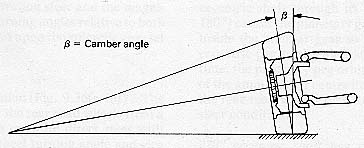 When a wheel has positve camber, due to the elasticity of tyres, the wheel will be reshaped to something like the base of a cone. It will have a tendency to rotate about the peak of the cone, as shown in the picture. Now, you will see the wheel tries to steer away from the center of the car.
When a wheel has positve camber, due to the elasticity of tyres, the wheel will be reshaped to something like the base of a cone. It will have a tendency to rotate about the peak of the cone, as shown in the picture. Now, you will see the wheel tries to steer away from the center of the car.
If both the right and left wheels are positive cambered (that means they lean towards opposite directions), the steering tendency will be cancelled so that the car remains running in straight line. If the car is turning into a corner, body roll puts more weight on the outside wheels than the inside wheels, that means the outside wheel's steering tendency will have more influence to the car. As the positive-cambered outside wheel tries to steer the car to the outside of the corner, the car will be understeered.
On the contrary, if both wheels are negative cambered, the car will oversteer.
A Good Suspension must :
1) Provide independent shock absorption to individual wheels. That means, when one wheel rides over a hump, the shock will not be transferred to other wheels.2) Has adequate body roll. Excessive body roll leads to too much weight transfer thus influence the steering response. It is not comfortable too. Restrict body roll to minimal may create uncomfortable feeling because of excessive g-force. Moreover, body roll could provide information to the driver, telling him the state of cornering and whether the car has reached its limit. Completely eliminate body roll is not at all good.
3) Has a good geometry such that wheel cambers remain unchanged in all conditions, that is, acceleration, braking, cornering, load and bumps.
Body roll suppression usually conflict with ride comfort, because the former requires stiffer spring and dampers while the latter vice versa. Nevertheless, clever suspension geometry may improve body roll without altering the ride. Here in below we are going to discuss the most popular kinds of suspension geometry.
Non-independent suspension
Live / Dead axle
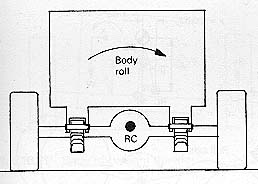 Until the late 70s, most cars still used this simple non-independent suspensions, especially at the rear axle. Basically, it is a rigid axle fixed between left and right wheels. The car body is suspended by leaf springs or coil springs on the axle / wheels unit.
Until the late 70s, most cars still used this simple non-independent suspensions, especially at the rear axle. Basically, it is a rigid axle fixed between left and right wheels. The car body is suspended by leaf springs or coil springs on the axle / wheels unit.As you can see, the wheels are not independent. When one wheel rides on a hump, the shock will be transferred to another wheel. Besides, both wheels will be cambered, thus non-neutral steering is inevitable.
If the axle is also the driving axle, it is called Live Axle. Live axle is very heavy. It consists of the final drive / differential, drive shafts and a strong tube enclosing all these things. Since the whole axle is rigidly fixed to the wheels instead of suspended by springs, the so-called Unsprung Weight is very high.
What is the result of high unsprung weight ? Assuming a live axle meets a hump and "jump" quickly upward, the more weight it has, the more momentum it gains (because momentum = the product of mass and velocity). That means the more momentum the springs have to deal with. Of course, springs cannot absorb all the momentum, so eventually part of the latter will be transferred to the car body in the form of shock. Therefore live axle is never good at ride quality.
If the axle is not the driving axle, it is called Dead Axle. Without the driving mechanism incorporated, dead axle has much less unsprung weight, so its ride quality is better than Live Axle. Anyway, comparing them is useless - it does not make sense for a car to use dead axle in the non-drive wheels while using a suspension advancer than live axle in the driving wheels. Independent MacPherson suspension is rather easy and cost-effectively to replace the non-drive dead axle. If a car maker cannot afford such little additional cost, it must not willing to employ advancer suspensions in the driving wheels also.
Live / Dead Axle have another disadvantage - body roll is not sufficiently suppressed. Springs are the only element which control the body roll, however, stiffen the springs will inevitably deteriorate ride quality. Moreover, if coil springs are used, lateral force due to cornering will lead to transverse movement of the car body, thus result in weight transfer and affect steering response.
The popular solution was to add some control arms between the car body and the axle, such as Panhard rod and Watt link. However, they are out of our scope.
| Advantage: | Cheap. Body roll does not influence the camber of wheels. |
| Disadvantage: | Non-independent, bad ride quality, both wheels cambered on bump. |
| Who use it ? | Some American sedans, Ford Mustang, Falcon, most SUV. |
DeDion Axle
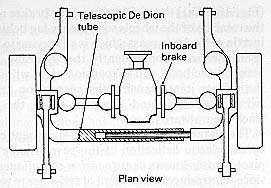 Although independent suspensions were invented decades ago, non-independent suspensions still dominated the market until the late 70s. The first reason was: cheap. The second reason: it offers quite good handling despite of poor ride. Since the wheels are rigidly linked by an axle, they remain perpendicular to the road surface regardless of body roll. Therefore the car corners quite stable. In contrast, in many types of independent suspensions, camber angle may be changed due to body roll.
Although independent suspensions were invented decades ago, non-independent suspensions still dominated the market until the late 70s. The first reason was: cheap. The second reason: it offers quite good handling despite of poor ride. Since the wheels are rigidly linked by an axle, they remain perpendicular to the road surface regardless of body roll. Therefore the car corners quite stable. In contrast, in many types of independent suspensions, camber angle may be changed due to body roll.However, as explained before, live axle has too much unsprung weight, thus leads to poor ride quality. Therefore many budget sports cars or coupes chose DeDion Axle (rear) suspensions over live axle.
DeDion axle suspension has much less unsprung weight because the final drive / differential and driving shafts are not rigidly attached to the wheels. Like independent suspensions, they are part of the car body and flexibly linked to the wheels by universal joints. In other words, they are sprung.
The wheels are interconnected by a DeDion Tube, which has a sliding joint to permit wheel track variation during suspension movement, this help refining ride quality too. The DeDion tube keeps both wheels parellel to each other under all conditions, so they are always perpendicular to the road surface regardless of body roll.
| Advantage: | Still cheaper than most independent suspensions. Body roll does not influence the camber of wheels. Better ride quality than Live Axle. |
| Disadvantage: | Non-independent, ride is still worse than independent suspensions. Both wheels cambered on bump. |
| Who use it ? | Caterham, Vector, Smart. |
Independent Suspensions

 This is a very old independent suspension, used by some sports cars since the 50s, such as VW Beetle, Porsche 356 (which was based on Beetle) and Mercedes' famous 300SL Gullwing (1954). However, it disappeared for at least 2 decades because it has so much weakness. The only advantage is - it provides independent shock absorption.
This is a very old independent suspension, used by some sports cars since the 50s, such as VW Beetle, Porsche 356 (which was based on Beetle) and Mercedes' famous 300SL Gullwing (1954). However, it disappeared for at least 2 decades because it has so much weakness. The only advantage is - it provides independent shock absorption.Handling is really awful, as camber angle can be noticeably changed by bouncing motion (as shown in the first picture), change of static weight of the car (second picture) and body roll (third picture). Especially is the body roll, which makes both wheels lean towards the corner, thus result in severe oversteer. This explain why the Mercedes 300SL Gullwing was criticised as very unpredictable and difficult to handle.
Camber variation can be reduced via using longer swing arms, but this could create problems in packaging. It engages the space for rear seats and even the boot.
Another solution is to introduce inherent understeer by setting the wheels negative cambered. This could compensate the oversteer during cornering but the drawback is the instability in straight line. To cars as slow as VW Beetle, swing axle shows its advantage in ride comfort over contemporary non-independent suspensions while the weakness in handling is not easily seen. For Porsche 356, at least in the less-powerful early versions, the problem is not severe, too. In later years, when the car got bigger and bigger engine, Porsche realised that the days for swing axle had nearly finished. That came true when the 911 launched in 1963, used trailing arm at the rear instead of swing axle.
| Advantage: | Independent ride. |
| Disadvantage: | Very bad handling. |
| Who use it ? | Mercedes 300SL (1954), VW Beetle, Porsche 356 etc. |
Double wishbones suspension
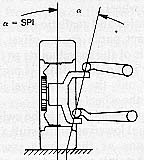 To many suspension designers, double wishbones (or "A-arms") is the most ideal suspension. It can be used in front and rear wheels, it is independent and most important, it has near perfect camber control. For 40 years and even today, this is the first choice for racing cars, sports cars and demanding sedans.
To many suspension designers, double wishbones (or "A-arms") is the most ideal suspension. It can be used in front and rear wheels, it is independent and most important, it has near perfect camber control. For 40 years and even today, this is the first choice for racing cars, sports cars and demanding sedans.Basically, double wishbones suspension always maintains the wheel perpendicular to the road surface, irrespective of the wheel's movement. This ensure good handling.
Traditional double wishbones consists of 2 parellel wishbone arms of equal length, which has the drawback of excessive tire scrubbing because of the large variation in track width as the wheel moved off the neutral position. Therefore engineers developed unequal-length non-parellel A-arms to solve this. By tilting the upper A-arm, anti-dive function is also achieved.
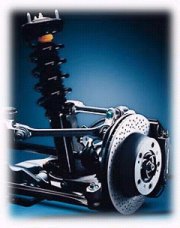 | << Porsche 993's rear suspension Double wishbones suspension has been very popular in American cars. Not so in Europe because cars in there are smaller thus cannot accommodate this relatively space-engaging suspension. Besides, it is more costly than MacPherson strut and torsion beam because it involves more components and more suspension pick up points in the car body. Owing to these reasons, very few small cars adopt it. One of the few examples is Honda Civic. This does not mean American cars have better handling. No, due to their larger size and weight and the less effort spent in suspension tuning, the majority of double wishbones-equipped American cars actually handles worse. |
| Advantage: | Ideal camber control leads to good handling. |
| Disadvantage: | Space engaging and costly. |
| Who use it ? | American sports cars and some sedans, most European pure sports cars like Ferrari, TVR, Lotus .... some Euopean sedans, most Honda .... many many many. |
MacPherson strut suspension
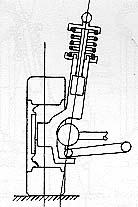 The MacPherson strut suspension was invented in the 1940s by Earl S. MacPherson of Ford. It was introduced on the 1950 English Ford and has since become one of the dominating suspensions systems of the world because of its compactness and low cost.
The MacPherson strut suspension was invented in the 1940s by Earl S. MacPherson of Ford. It was introduced on the 1950 English Ford and has since become one of the dominating suspensions systems of the world because of its compactness and low cost.Unlike other suspension designs, in MacPherson strut suspension, the telescopic shock absorber also serves as a link to control the position of the wheel. Therefore it saves the upper control arm. Besides, since the strut is vertically positioned, the whole suspension is very compact. To front-wheel drive cars, whose engine and transmission are all located inside the front compartment, they need front suspensions which engage very little width of the car. Undoubtedly, MacPhersion strut suspension is the most suitable one.
Nevertheless, this simple design does not offer very good handling. Body roll and wheel's movement lead to variation in camber, although not as severe as swing axle suspension. From a designer's viewpoint, its relatively high overall height requires a higher hood and fender line, which is not very desirable to sports cars' styling.
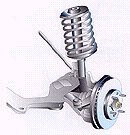 | << Hyundai Atoz's MacPherson strut Like double wishbones suspension, MacPherson strut can be adopted in both front and rear wheels. In the 80s, there are many budget sedans employed Mac strut in all corners, the most famous is Fiat's Type 4 and Tipo platforms, on which Fiat Croma, Lancia Thema, Saab 9000, Fiat Tipo, Tempra, Lancia Delta, Dedra etc. were based. None of them was famous of handling. Basically, Alfa Romeo's GTV / Spider is also based on the Tipo platform, however, after experienced unsatisfatory handling during testing, the rear MacPherson struts were replaced by the pricier multi-link suspensions. |
| Advantage: | Compact and cheap. |
| Disadvantage: | Average handling. |
| Who use it ? | Most front-wheel drive compact cars. |
- Air cooled diesel engine
- Transmission Repair
- Diesel Engine
- Petrol Engine
- Writing a business plan
- Suspension
- Used marine diesel engines
- Phone Number
